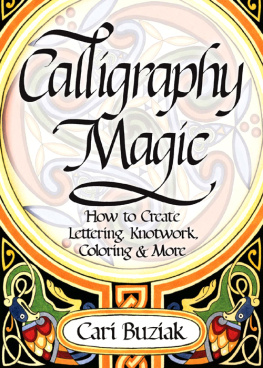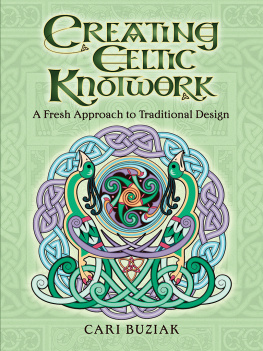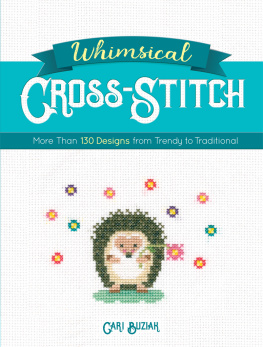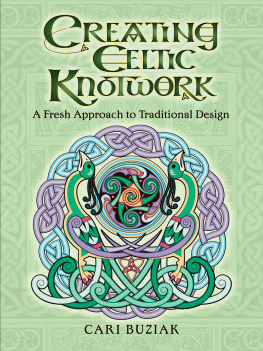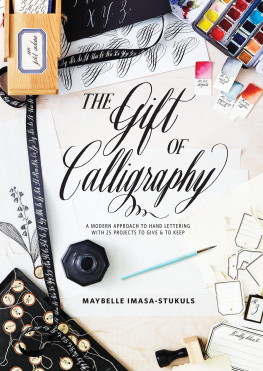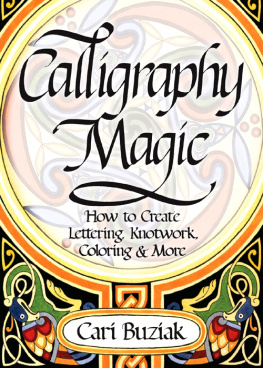Calligraphy is a fun craft to learn, as well as a useful one. Far from being an obsolete skill, more and more people today are picking up the pen and creating their own greeting cards, wedding invitations, fine art projects, and even creating their own computer fonts!
In the old days, calligraphy tools were unique and specifically crafted to their task. Today, a calligrapher has a wide variety of tools from which to choose, from traditional to completely modern, even digital! Calligraphers can now experiment with their artistic expression, freely mixing creative ideas and elements together to explore new artforms with their projects. In this book well examine the basic techniques of calligraphy, covering calligraphy hands suitable for a wide variety of projects and easy for a beginner or intermediate calligrapher to practice and learn. Well also cover easy decorative techniques such as watercolor painting, Celtic knotwork, gold leafing and illustration ideas to create a toolkit of creative techniques. Youll learn how to make your own wedding stationery, create a painted greeting card or a birth announcement, design a logo for your own business, and so much more! Well cover all the steps from basic layout to design choices to the final completed piece in easy step-by-step examples.
Calligraphy is a way of expressing yourself and learning something new in an art field that has lots of potential for new discoveriesfinding new ways to embellish your lettering, learning a new alphabet, or creating memorable keepsakes with a handmade touch for yourself, family and friends.
Glossary of Terms
Ascenders & Descenders
A letter has three main parts: the x-height, the ascender, and the descender. The main body of the letter fills the x-height (for example, the lowercase o); the ascender rises up above the x-height (the stem of the d); and the descender falls below the x-height (the stem on the lowercase p).
Font
A typeface (alphabet) used on a computer (as opposed to letters used on a printing press, or hand written).
Font Family
A font family includes a number of related font faces, such as a bold version, condensed, italic, light, etc.
Cursive
A more fluid or script style of writing, developed as a faster way to write by monks. Cursive usually has a looser and less formal look. Its useful for projects that need letters that flow and move in the design without looking too formal or stiff.
Majuscule
Capital or uppercase letters in an alphabet. Also great for creating a splash at the beginning of a text with a larger or more detailed letter. Often used for monograms, or a detailed piece in stand-alone uses where there may not be any other text or designs in a project. A highly decorated Majuscule used at the beginning of a word or sentence is called a Display Capital.
Minuscule
Lowercase letters in an alphabet. Some minuscule letters lend an informal look to a piece of text, and can be used in projects where a lighter or more inviting feel is desired.
Uncial
A style of writing characterized by full, rounded letters. Capitals from our modern Latin alphabet are derived from Uncial style letterforms.
Serif
A small stroke at the beginning or end of a main stroke. A serif can be made in many ways and often gives a particular alphabet its characteristic look.
Glyph
Any graphic within a font. This can be a letter, number, or a symbol such as a dollar sign or punctuation.
Encoding
Each glyph is encoded with instructions so that the computer knows to type an A when you press the A key on your keyboard. At one time Macs and PCs used different encoding instructions or standards; however the new Unicode Standard is a universal standard that both Macs and PCs will recognize and understand and what well be using in our discussions here.
Metrics
Spacing rules that you want your font letters to follow so that theyre spaced correctly when you type words and paragraphs.
Color Hue/Tint/Shade
Hue is pure color. Tint is color plus white. Shade is color plus black.
Complementary Colors
Colors opposite each other on the color wheel. Complementaries can create strong and bold color pairings.
Triad Colors
Three colors, each one-third away from each other on the color wheel. Triads can also create a very bold color combination.
Split Complementary Colors
Instead of using the direct complementary color, you use the two colors to either side of the complementary. This combination is more subtle, and good for more reserved pieces.
Gilding
The application of tissue-thin sheets of metal (gold, silver, copper) to a sticky surface.
CHAPTER 1
Calligraphy Tools and Supplies
Calligraphy is not an expensive craft to learn. With some basic pen supplies and papers you can immediately begin learning how to create beautiful letters.
Sketching Tools
To sketch your designs and plan your layout youll need a pencil or two and a good eraser. These actually come in a much wider variety than what weve all used in grade school! Having a few choices in pencil leads and a good eraser to use can mean the difference between fighting your materials while you work, and getting into the groove of your project, so its more than worth the small cost to purchase these.

PENCIL HARDNESS
Pencils come in different hardnesses of lead, from 6B (which draws very soft, smudgy black lines) to 6H (which draws hard, thin, silvery lines). For calligraphy or for sketches that will be colored over, buying a normal HB pencil and a 2B or 2H will suffice.

TYPES OF PENCILS
You can buy your pencils as normal pencils that are sharpened with a pencil sharpener, a holder that can accept leads of any hardness, or a mechanical pencil. I prefer to work with mechanical pencils because they dont have to be sharpened. I buy a few of those brightly colored plastic mechanical pencils in different colors and color-code what pencil holds which hardness of lead.

